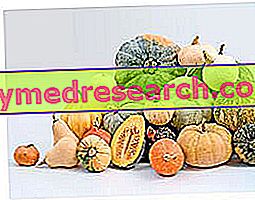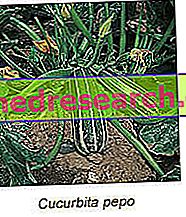Introduction
Which vegetable better than pumpkin could embody the symbol of Halloween? The pumpkin, in addition to being an ideal expedient for creating monstrous shapes illuminated internally by lanterns, lends itself very well to preparing exquisite dishes - typically autumnal and winter - tasty, sweet and low-calorie, therefore also suitable for those who follow dietary regimens with low calories.

A common vegetable in many different cultures, the pumpkin lends itself to being prepared in a great many ways, from cooking in the oven to cooking in a pan, from boiling to frying, from the preparation of tempting pasta sauces (and rice), to that of sweets and cakes typical of the cold season.
Moreover, the pumpkin is a medicinal bomb: for this reason, it is used both in herbal medicine and in cosmetics.
Pumpkin: generalities
The name "pumpkin" refers to a variety of fruits belonging to the Cucurbitaceae family: more often than not, the pumpkin itself is identified by the genus Curcubita, but some species belong to the genus Lagenaria, comprising, in general, pumpkins cultivated with fine for the most part ornamental, with thick and very hard skin, and almost without pulp. Curcubita pepo is the term that indicates the popular zucchini (whose fruits of the homonymous plant are consumed immature), while the botanical binary Curcubita maxima refers to real pumpkins, pulpy, orange and sweet peponids, harvested at full maturity.
Particular is Curcubita moschata ( violin pumpkins) with a “pear” shape: swollen, tinged with green at the base, pointed and yellow-orange in color towards the apical part.
Pumpkin originates from Central America: its origins are very ancient and in the past it was a precious food source to feed many peoples.
Botanical aspects
The pumpkin is an annual plant, monoecious and herbaceous, with a climbing or scanting stem, up to 7 meters long, covered with bristly hairs and rich in racemose tendrils. The leaves are rather large and pedunculate, heart-shaped and made up of 5 lobes.

The pumpkins grow well in medium-textured, fresh soils, enriched with organic matter, preferably acid pH; however, these plants adapt to every type of soil. Pumpkins prefer warm temperate climates: they grow easily at a temperature between 18 and 24 ° C.
Pumpkin: variety
More specifically, all pumpkins can be classified into four large groups:
- Cucurbita maxima
- Cucurbita moschata
- Cucurbita melanosperma : also called squash spaghetti for the consistency of its cooked pulp, comparable to angel hair. It is a particular plant, typical of East Asia, and native to Mexico.
- Cucurbita pepo
- Lagenaria: ornamental pumpkins, formerly used also as containers for water or wine.

According to another classification less "scientific", the pumpkins are listed in:

- Winter squash ( Cucurbita maxima and Cucurbita moschata ):
- The maxima species also includes the so-called "turban variety", widely cultivated in the hundredth and in southern Italy for ornamental purposes, for its bright colors and for its irregular and lumpy shape. The turban pumpkin is widely used to make the famous Halloween pumpkins, due to the peculiarity given by the original hat. Remember also the gray pumpkin of Bologna, excellent from jams, and the marine pumpkin of Chioggia, huge, elliptical with green skin and orange pulp.
- Among the pumpkins belonging to the moschata species, we must not forget the full pumpkin of Naples, whose fruit is rather long, cylindrical, inflated at the ends: the pulp is sweet, yellow or orange, while the surface is yellow, sometimes tending to reddish.
Video Recipe - Pumpkin pie and low-calorie apples: no butter and no eggs
Rustic Pumpkin Pie Without Butter and Without Eggs
X Problems with video playback? Reload from YouTube Go to Video Page Go to Video Recipes Section Watch the video on youtube




